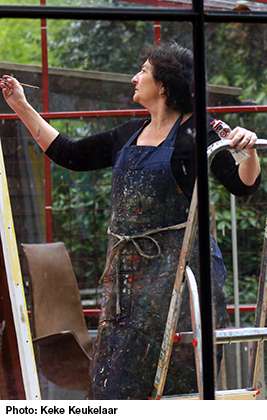|
DORA DOLZ 1941-2008 by Hans Walgenbach*
“I want to make sculptures on a human scale, not monuments…”
From 1967 to 1971, Dora studied Monumental and Graphic Arts at the Rotterdam Academy of Visual Arts (now the Willem de Kooning Academy). Even when her son Pedro was born in 1969, she continued this study. She took the baby with her to the painting lessons of Jan Jongert and Kees Franse. Due to the large cultural differences between Barcelona and Rotterdam, she was consumed by homesickness in those years. “Kees Franse taught me to love the Netherlands. Without him I would not have integrated here," Dora herself said in an interview in the Algemeen Dagblad of November 30, 2007.
With her baby she was a remarkable appearance among the generally younger fellow students. But that wasn't the only reason Dora stood out. She immediately distinguished herself with her work, which was completely different in nature and atmosphere than what was made at the academy at that time. Her passion and melancholic non-Dutch character impressed students and teachers. She painted life-size portraits of some of them in soft muted colors. Some of these were on display in 1973 in Het Venster gallery in Rotterdam, including a double portrait of the Rotterdam visual artists Woody van Amen and Will Rockx.
Yet it is mainly the still life with which Dora worked intensively from 1972 onwards and in which she developed her own handwriting and her typical Dolz motifs: the fan, the vase, the bunch of grapes, the mountain, the stylized wave, the cloud, the curtain, the stairs, the fruit bowl, the snail, the butterfly and the chaise longue. Over the years, they acquired their own symbolism and meaning in a design language that is so very recognizable as ‘Dora Dolz’.
The relaxed creative power, the imaginative and colorful representations are undoubtedly important characteristics of Dora's work, which is sometimes called a feast of color and inventiveness, but is therefore not necessarily cheerful. Vanitas is the most important and recurring theme throughout her oeuvre. Her glass objects, for example, portray the idea of vanitas with their glass crowns symbolizing vanity and past associations with devilish forces. 'No, I'm not the happiest, even though all these things are decorated with beautiful ornaments.' (Dora Dolz on the occasion of receiving the Jeanne Oosting Prize 2006.)
In the moving series of paintings: 'Fallen Angels', which was created after 2001,
This marriage of life and art was perhaps Dora's most important work of art. Nowhere was this more visible than in her house on the Heemraadssingel, where she received her extensive circle of friends from Rotterdam's cultural life. The interior design of the house was a mirror of her life. Her glass royal crowns, farmhouse silver mirrors, vases and bowls were displayed on large shelves, in cupboards and on tables, together with earthenware tableware and the many other items she collected over the years. On the floor were her colorful rugs with their whimsical motifs, some rolled out, double-layered, and the elaborately designed glass lamps swayed gently from the ceilings. Works of art made by herself and by friends hung on the walls throughout the house, marking a life of forty years as an artist.
Her daughter, the filmmaker Sonia Herman Dolz, captured this life in 2006 in a beautiful documentary 'Portrait of Dora Dolz'. The film, which is permeated with homesickness, memories and unfulfilled desires, shows her as she viewed life: authentic and passionate, as a woman, mother, grandmother, neighbor, teacher, as an artist. “Yo soy así,” she says somewhere in the film. "This is me!" It was Dora's strongest asset.
Major monumental works were in progress when she was struck by her illness. 'She was felled in armor', we say in the Netherlands. 'With the boots still on' is what they call it in Spain. At the end of January 2008, Dora was awarded the Wolfert van Borselen Medal by the municipality of Rotterdam as a token of appreciation for the significance and influence of her work for the city. A retrospective exhibition was on display in Museum Boijmans Van Beuningen. She enjoyed that interest in her art. On March 1, 2008, Dora also received Spanish recognition with a Royal award. Unfortunately, she was not allowed to experience this again; she would have been extremely proud of it.
Hans Walgenbach is former director of CBK Rotterdam and the Historical Museum city of Rotterdam.
|



 'Dora Dolz makes beautiful work: nothing comparable can be found in the Netherlands'.
'Dora Dolz makes beautiful work: nothing comparable can be found in the Netherlands'.